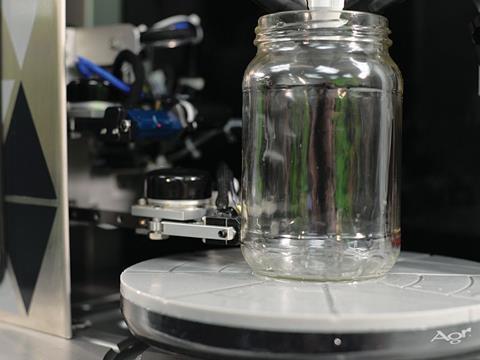
Agr International, Inc. recently announced the introduction of the Combined Coating Measurement System (CCMS) for measuring metallic coatings on both the finish and body regions of glass containers.
This totally new device provides operators with a one-stop, single operation testing station for measuring tin oxide coatings applied to the container during the production process.
This system utilizes Agr’s proven reflective coating measurement technology as a foundation and features a fully automated measurement approach. By incorporating a number of technological advances in combination with automation, Agr has been able to achieve a 33% improvement in testing throughput and a 70% improvement in precision with this device over previous coating measurement systems. Some of the features incorporated into the CCMS include:
• Finish and/or body measurements in one operation
• Dual head design
• Universal hold down mechanism
• Automated test or spot check operation
• Secure Linux-based operating system
• Industry 4.0 ready
• Software-based calibration
• Advanced electronics for better precision
According to Agr sources, the basic goal of the CCMS development program was to provide the industry with a leading-edge system that could provide the measurement precision needed for process management requirements while reducing the labor intensity of coating measurement.
Two heads are better than one
In order to achieve maximum precision on finish and body measurements, the CCMS incorporates dedicated measurement heads for each of the finish and body regions. One head is optimized to operate with the precision necessary for the limited area of the finish region. The second head is configured for body measurements where larger areas and heavier coatings are encountered. The advanced electronics of the system, in conjunction with dedicated measurement heads for finish and body, make it possible to precisely identify the presence of very small amounts of coating in the finish region while measuring heavier coating levels applied to the body of the container, all in one operation.
Automated, one-touch operation
The CCMS is designed for fully automated operation. Positioning of measurement heads, including vertical height location, container rotation and capture of measurement data is performed in a single progression, without the need for operator intervention during the testing sequence. Jobs can be created to measure the body or finish regions individually or a combination of both.
For additional operator convenience, the system offers two testing modes. The “spot test” measurement mode affords the operator the ability to take a quick spot measurement on a single container location. The “job-based” test mode provides the operator with the ability to create and store jobs that can be used to measure multiple containers of the same type. In this mode, each measurement is performed at the same locations on the container body and/or finish, as defined by the job, on every container in the set.
The CCMS provides a wealth of test data. Measured values are presented in easy to understand color-coded graphic format for each test in progress, to permit operators to readily identify measurements that fall outside of acceptable ranges. Job-based numerical results are also available in spreadsheet form, detailing the min/max/average data for each measurement (height and angle) for both body and finish regions on every container.
The CCMS incorporates a Linux-based architecture and operating system to manage the continuous, multi-function operations of this system. Linux was chosen for its ability to run efficiently on the embedded computing platform that manages the CCMS test operations as well as its proven stability, security and long-term availability.
According to Robert Cowden, AGR’s Chief Operating Officer, “The CCMS product encapsulates Agr’s unique, high value added relation to the global glass container industry by combining an innovative, proven measurement technique developed years ago by American Glass Research scientists with current state of the art electronics, operating system and automation technology.”











